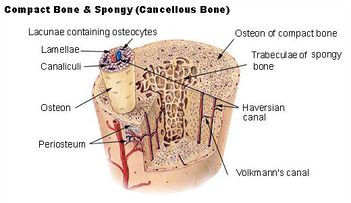Bone: Difference between revisions
Candace Goh (talk | contribs) No edit summary |
Candace Goh (talk | contribs) No edit summary |
||
| Line 26: | Line 26: | ||
==== Individual bone structure ==== | ==== Individual bone structure ==== | ||
[[File:Bone 2.jpg|none|thumb|351x351px]] | |||
*'''Compact/cortical bone''' | *'''Compact/cortical bone''' | ||
*'''Cancellous/spongy bone''' | *'''Cancellous/spongy bone''' | ||
Revision as of 16:48, 23 September 2018
This article is currently under review and may not be up to date. Please come back soon to see the finished work! (23/09/2018)
Original Editors -
Top Contributors - Lucinda hampton, Candace Goh, Admin, Shaimaa Eldib, Kim Jackson, Jess Bell, Wataru Okuyama, Claire Knott, Manisha Shrestha, Khloud Shreif, Robin Tacchetti, George Prudden, Joao Costa, Sai Kripa, Tony Lowe, Stephanie Geeurickx and WikiSysop
Bones are connected to each other to form skeleton, which forms the framework of the body.
Functions[edit | edit source]
Mechanical[edit | edit source]
- Protection
- Gives shape and support to the body
- Movement
Synthetic[edit | edit source]
- Manufactures blood cells
Metabolic[edit | edit source]
- Mineral storage
- Fat storage
- Role in acid-base balance
Structure[edit | edit source]
Gross anatomy[edit | edit source]
Individual bone structure[edit | edit source]
- Compact/cortical bone
- Cancellous/spongy bone
Cellular structure[edit | edit source]
Molecular structure[edit | edit source]
Matrix[edit | edit source]
- Inorganic
- Organic
Woven or lamellar[edit | edit source]
Types[edit | edit source]
Formation[edit | edit source]
Intramembranous ossification[edit | edit source]
Endochondral ossification[edit | edit source]
Bone marrow[edit | edit source]
Remodeling[edit | edit source]
Purpose[edit | edit source]
Calcium homeostasis/balance must exist between osteoclasts and osteoblasts activity[edit | edit source]
- If too much new tissue is formed, the bones become abnormally large and thick (acromegaly)
- Excessive loss of calcium weakens the bones, as occurs in osteoporosis
Repair[edit | edit source]
Paracrine cell signalling[edit | edit source]
Osteoblast stimulation[edit | edit source]
Osteoclast inhibition[edit | edit source]
Disorders[edit | edit source]
- Osteoporosis
- Osteoarthritis
- Osteomalacia
- Rickets
- Epiphyseal plate disorders
References[edit | edit source]
see adding references tutorial.







